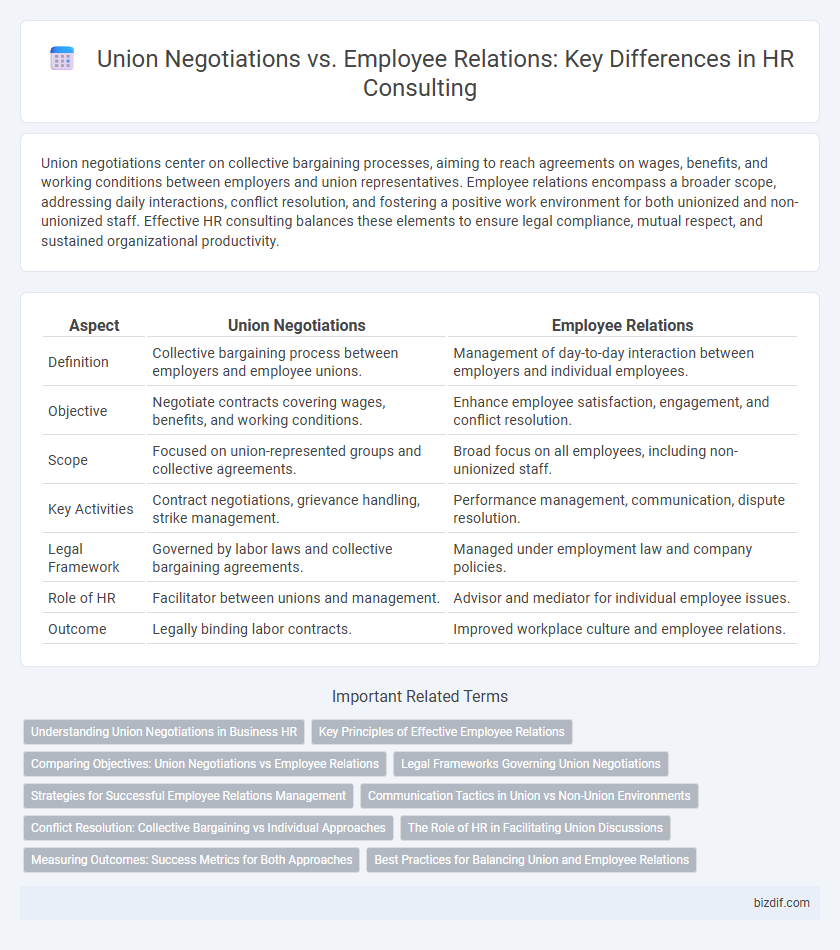Union negotiations center on collective bargaining processes, aiming to reach agreements on wages, benefits, and working conditions between employers and union representatives. Employee relations encompass a broader scope, addressing daily interactions, conflict resolution, and fostering a positive work environment for both unionized and non-unionized staff. Effective HR consulting balances these elements to ensure legal compliance, mutual respect, and sustained organizational productivity.
Table of Comparison
| Aspect | Union Negotiations | Employee Relations |
|---|---|---|
| Definition | Collective bargaining process between employers and employee unions. | Management of day-to-day interaction between employers and individual employees. |
| Objective | Negotiate contracts covering wages, benefits, and working conditions. | Enhance employee satisfaction, engagement, and conflict resolution. |
| Scope | Focused on union-represented groups and collective agreements. | Broad focus on all employees, including non-unionized staff. |
| Key Activities | Contract negotiations, grievance handling, strike management. | Performance management, communication, dispute resolution. |
| Legal Framework | Governed by labor laws and collective bargaining agreements. | Managed under employment law and company policies. |
| Role of HR | Facilitator between unions and management. | Advisor and mediator for individual employee issues. |
| Outcome | Legally binding labor contracts. | Improved workplace culture and employee relations. |
Understanding Union Negotiations in Business HR
Union negotiations in business HR involve structured dialogues between employers and union representatives to establish collective bargaining agreements that address wages, working conditions, and employee benefits. Effective union negotiation strategies require a deep understanding of labor laws, union demands, and the company's operational goals to foster mutually beneficial outcomes while minimizing labor disputes. By prioritizing transparent communication and collaborative problem-solving, HR professionals can enhance labor relations and maintain organizational stability.
Key Principles of Effective Employee Relations
Effective employee relations prioritize open communication, mutual respect, and proactive conflict resolution to foster a positive workplace culture. Unlike union negotiations that focus primarily on collective bargaining and contract terms, employee relations emphasize ongoing dialogue, trust-building, and individual employee engagement. Implementing transparent policies and consistent management practices strengthens organizational commitment and reduces workplace disputes.
Comparing Objectives: Union Negotiations vs Employee Relations
Union negotiations primarily focus on collective bargaining to establish terms of employment, such as wages, benefits, and working conditions, aiming to reach agreements between unions and management. Employee relations emphasize fostering positive workplace culture, addressing individual employee concerns, and improving communication to enhance job satisfaction and productivity. While union negotiations target formal contract outcomes, employee relations prioritize ongoing engagement and conflict resolution at the individual and organizational levels.
Legal Frameworks Governing Union Negotiations
Legal frameworks governing union negotiations are primarily defined by the National Labor Relations Act (NLRA), which protects employees' rights to organize and bargain collectively. Compliance with regulations enforced by the National Labor Relations Board (NLRB) is critical to ensuring lawful negotiation processes and resolving unfair labor practices. Understanding jurisdiction-specific labor laws and precedents is essential for HR consultants to navigate union interactions effectively and mitigate legal risks.
Strategies for Successful Employee Relations Management
Effective employee relations management prioritizes transparent communication, proactive conflict resolution, and consistent policy enforcement to foster trust and cooperation within the workforce. Implementing tailored training programs enhances managerial skills in handling diverse employee concerns while aligning organizational goals with employee needs. Leveraging data analytics and feedback mechanisms supports continuous improvement in employee engagement and workplace harmony, reducing the risk of union disputes.
Communication Tactics in Union vs Non-Union Environments
Effective communication tactics in union negotiations emphasize transparency, active listening, and collaborative problem-solving to build trust and prevent conflicts during collective bargaining. In non-union employee relations, communication focuses on regular feedback, open dialogue, and proactive engagement to foster a positive workplace culture and address individual concerns promptly. Tailoring communication strategies to the unique dynamics of union and non-union settings enhances employee satisfaction and organizational stability.
Conflict Resolution: Collective Bargaining vs Individual Approaches
Union negotiations involve collective bargaining processes where HR professionals mediate between management and employee unions to resolve conflicts through agreed-upon contracts, ensuring workforce stability and compliance with labor laws. Employee relations focus on individual approaches, addressing personal disputes and grievances through direct communication and tailored conflict resolution strategies to maintain a positive work environment. Effective conflict resolution in HR consulting requires balancing collective negotiation tactics with personalized interventions to optimize organizational harmony and productivity.
The Role of HR in Facilitating Union Discussions
HR plays a critical role in facilitating union discussions by acting as a mediator between management and union representatives, ensuring transparent communication and adherence to labor laws. Effective HR strategies help balance organizational goals with employee demands, fostering a collaborative environment that mitigates conflict during union negotiations. Proactive employee relations practices, combined with skilled negotiation tactics, enable HR to support constructive dialogue and achieve mutually beneficial agreements.
Measuring Outcomes: Success Metrics for Both Approaches
Union negotiations success is typically measured by contract terms secured, dispute resolution frequency, and strike occurrences, while employee relations outcomes focus on employee satisfaction scores, retention rates, and workplace conflict reduction. Key performance indicators (KPIs) for union negotiations include collective bargaining agreement effectiveness and grievance resolution time, whereas employee relations prioritize engagement surveys and turnover metrics. Both approaches require customized metrics aligned with organizational goals to accurately assess impact and drive continuous improvement.
Best Practices for Balancing Union and Employee Relations
Effective HR consulting emphasizes transparent communication and proactive engagement with both union representatives and non-union employees to foster trust and collaboration. Implementing inclusive policies that address collective bargaining concerns while supporting individual employee needs strengthens organizational harmony and reduces conflict. Regular training on labor laws and conflict resolution equips HR professionals to balance union negotiations with ongoing employee relations effectively.
Union Negotiations vs Employee Relations Infographic

 bizdif.com
bizdif.com